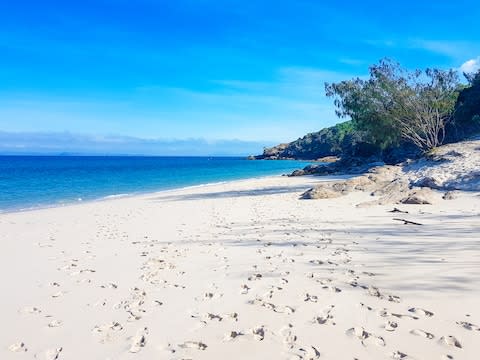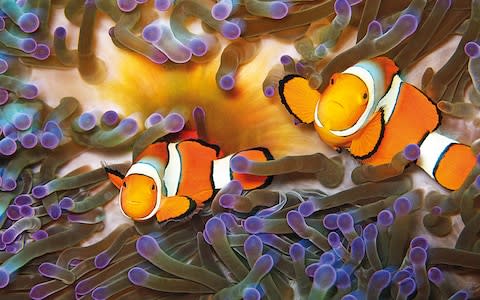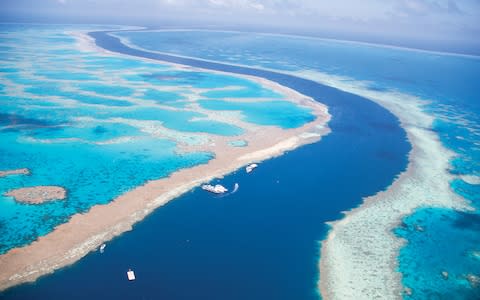The curious tale of XXXX Island – from beer-soaked man cave to tropical idyll

It’s dusk, and I’m standing alone on the highest point of this scrap of earth in the Southern Great Barrier Reef. Below, my tiny cottage is snugged down on the tail end of the island at Pebble Point, its hammock-strung private deck and tiny plunge pool overlooking rocks and ocean. I’m contemplating a quiet, contented evening of throwing a juicy steak on the Weber barbecue, and cracking open a bold Australian red while listening to the waves on the shore as the sky turns orange then black and the lights of the mainland twinkle and glow on the horizon – knowing there’s absolutely no one else around. Between here and there is just ocean and the other 16 islands of the Keppel archipelago, uninhabited apart from low-key Great Keppel Island.
Pumpkin Island, just an acre and a half in area, has only five sun and-wind-powered cottages and two beach bungalows scattered along its shoreline: one of the Great Barrier Reef’s most intimate island resorts, it has space for around 30 guests. Other than the cottages there is a breeze-filled open beach bar, a raised lookout area and a small play area for children.
It is a dinky little secret, and this could be because it has only been back on the market for two years, having been on secondment in a very different guise. Australians might recognise this as XXXX Island – as in the lager whose British adverts proclaimed that “Australians couldn’t give a Castlemaine XXXX for anything else”.
Between 2012 and 2015, Pumpkin was a tropical island-shaped man cave, leased by that Queensland brewer to host 3,000 competition winners of breaks to a men-only hideaway described as “less Club Med, more Club Shed”. In March 2016 the island was handed back. Now, there is no trace of the previous incarnation. Pumpkin has been seamlessly transformed into an exquisitely laid-back boutique retreat.
The new focus is on couples, families and multi-generational takeovers. Sheltered bays mean children can swim in crystal-clear waters ideal for snorkelling with fringing reefs edging the island – no long boats trips out to a reef. For all its glories, Pumpkin is strangely affordable. You could book the entire island and the cost per person per night would average out at AUS$96 (£55).

The best day is the day we take off on a boat belonging to island owners Wayne and Laureth Rumble and jump out over the fringing reef. They time it with the tides for better visibility. I’m snorkelling, but younger children can float on boogie boards with see-through viewing sections, or in the glass-bottomed boat. After all the depressing recent news about the Great Barrier Reef, it’s lovely to see healthy, squishy soft corals and vibrant fish. We see butterfly fish, clownfish, triggerfish and damselfish. This archipelago is the place to tick off the “Great 8” wild marine creatures – including clownfish (found in sheltered reefs or lagoons, or hiding between the stinging tentacles of anemones); sharks; manta rays; curious Maori wrasse; potato cod, with their enormous gaping mouths; giant clams; and turtles.
Later that day, by the family’s cottage, Wayne’s sister sends a drone to investigate a shadow in the water across the bay – it is two turtles mating. The turtle nesting season runs from November to March and January is prime time for visiting voyeurs. Next-door Great Keppel Island is where people watch them hatch and scurry to the ocean.

The catchphrase that promoted the island successfully in the Eighties – “Great Keppel Island: it’s a great place to get wrecked” – doesn’t do the island service today. We just note a quiet collection of tents, cabins and bungalows on a beach that’s as spectacular as anything in the Whitsundays. Within walking distance of the ferry drop-off, there are turtles, colonies of clownfish and giant clams to see underwater. When the tide is right you can watch the reef sharks feed at Clam Bay. Maori wrasse are abundant at Egg Rock, which is great for snorkelling, and the bar and bistro area is the perfect place for a lunchtime burger and to watch the empty, white palm-shrouded beach plunge down in front of you. They are preparing for a small barefoot wedding when we visit. My mental note is to come back – and for as long as possible. You can stay in a basic cabin here for around AUS$40 a night.

Despite all the stories about the colossal “bleaching” of coral reefs, induced by global warming, and the devastation depicted in documentaries such as Chasing Coral, the Great Barrier Reef is still the number one experience British travellers aspire to when they are planning a holiday to Queensland. At 1,430 miles (2,300km) long, this is the world’s largest coral system – but 80 per cent of tourism unfolds on about seven per cent of the reef, so it is also very managed.
The reef is an emotive, highly political topic, with scientists at loggerheads about the complex causes of its decline and locals nervous about tourism failing – the reef contributes more than AUS$6 billion to the Australian economy. But everyone is unified on one thing: tourism makes a vital contribution towards reef protection – anyone who visits contributes AUS$6.50 per day to the Great Barrier Reef Marine Park Authority, the reef custodians. In Yeppoon on the mainland I had breakfast with reef scientist and passionate diver Alison Jones, who argued that causes of coral death were myriad, and put the case for optimism amid the destruction. The fringing reefs here, only seven miles (12km) offshore, have been through a lot and it’s not a new thing. For example, a flood destroyed 85 per cent of coral cover in 1991. The reef ebbs and flows and regenerates. It is, Alison says, a reality of “doom and boom”. The coral here is so close to the mainland that is has evolved to be more sediment-tolerant, she says.

With more than 1,050 islands to choose from, it can be hard to know where to go. The Southern Great Barrier Reef has smaller operators, humbler resorts and is quieter. Pumpkin is a 45-minute bob by ferry from Yeppoon and there are no expensive helicopters as alternatives. The archipelago is unspoilt, with no shops, cars and bars. There are paddleboats and sea kayaks and stand-up paddle boards, but pottering around, lying in a hammock, oyster shucking and birdwatching are among the less stenuous options. With no dress code, Pumpkin screams “Stop! Slow down! Do nothing!” like nowhere else I have been in years.
How to get there
For packages to Queensland, try the Ultimate Travel Company (020 7386 4610; theultimatetravelcompany.co.uk). For more on visiting Pumpkin Island see its website.
